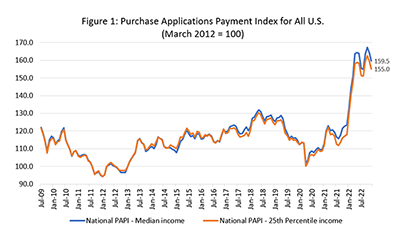
Mortgage Application Payments Fall 2.9% to $1,920 in December

Homebuyer affordability improved in December, with the national median payment applied for by purchase applicants decreasing 2.9 percent to $1,920 from $1,977 in November, the Mortgage Bankers Association reported.
The MBA Purchase Applications Payment Index measures how new monthly mortgage payments vary across time – relative to income – using data from MBA’s Weekly Applications Survey.
This month’s release includes a new dataset on applications for newly built single-family homes from MBA’s Builder Application Survey data. The new index – based on the BAS – is the Builders’ Purchase Application Payment Index.

“There was a slight improvement in homebuyer affordability last month as mortgage rates fell by 37 basis points from November,” said Edward Seiler, MBA Associate Vice President of Housing Economics and Executive Director of the Research Institute for Housing America. He noted while overall homebuyer affordability did increase, the median purchase application payment amount last month increased nearly $3,000 to $300,000.
“With inflation cooling slightly, MBA expects both mortgage rates and home-price growth to soften, which along with cooling inflation, should help bring more prospective buyers into the market during the spring homebuying season,” Seiler said.
The December Builders’ Purchase Application Payment Index showed that the median mortgage payment for purchase mortgages from the Builders’ survey was $2,399 in December 2022. Compared to December 2021, the media mortgage payment was $1,770 – representing a 35.5 percent increase in 2022.
An increase in MBA’s PAPI – indicating declining borrower affordability conditions – means the mortgage payment to income ratio is higher due to increasing application loan amounts, rising mortgage rates, or a decrease in earnings. A decrease in the PAPI – indicating improving borrower affordability conditions – occurs when loan application amounts decrease, mortgage rates decrease or earnings increase.
The national PAPI (Figure 1) decreased 2.9 percent to 159.5 in December from 164.2 in November, representing a further decline in the PAPI since a series high in October 2022. Compared to December 2021 (123.5), the index jumped 38.8 percent in 2022. For borrowers applying for lower-payment mortgages (the 25th percentile), the national mortgage payment decreased to $1,279 in December from $1,289 in November.
Additional Key Findings of MBA’s Purchase Applications Payment Index (PAPI) – December 2022
- The national median mortgage payment was $1,920 in December, down from $1,977 in November and from $2,012 in October. Mortgage payments increased $534 in 2022, equal to a 38.8% increase.
- The national median mortgage payment for FHA loan applicants was $1,602 in December, down from $1,631 in November and up from $1,070 in December 2021.
- The national median mortgage payment for conventional loan applicants was $1,954, down from $1,994 in November and up from $1,447 in December 2021.
- The top five states with the highest PAPI were: Nevada (259.2), Idaho (248.4), Arizona (219.2), Utah (213.9) and Florida (204.7).
- The top five states with the lowest PAPI were: North Dakota (102.1), Vermont (105.0), Washington, D.C. (106.6), Connecticut (109.9), and West Virginia (115.0).
- Homebuyer affordability increased for Black households, with the national PAPI decreasing from 164.2 in November to 159.5 in December.
- Homebuyer affordability increased for Hispanic households, with the national PAPI decreasing from 157.0 in November to 152.5 in December.
- Homebuyer affordability increased for White households, with the national PAPI decreasing from 165.4 in November to 160.6 in December.
About MBA’s Purchase Applications Payment Index
The Mortgage Bankers Association’s Purchase Applications Payment Index measures how new mortgage payments vary across time relative to income. Higher index values indicate that the mortgage payment to income ratio is higher than in a month where the index is lower. Contrary to other affordability indexes that make multiple assumptions about mortgage underwriting criteria to estimate mortgage payment level, PAPI directly uses MBA’s Weekly Applications Survey data to calculate mortgage payments.
PAPI uses usual weekly earnings data from the U.S. Bureau of Labor Statistics’ Current Population Survey. Usual weekly earnings represent full-time wage and salary earnings before taxes and other deductions and include any overtime pay, commissions, or tips usually received. Note that data are not seasonally adjusted.
MBA’s Builders’ Purchase Application Payment Index uses MBA’s Builder Application Survey data to create an index that measures how new mortgage payments vary across time relative to income, with a focus exclusively on newly built single-family homes. As with PAPI, higher index values indicate that the mortgage payment to income ratio is higher than in a month where the index is lower. To create BPAPI, principal and interest payment amounts are deflated by the same earnings series as in PAPI.
The rent data series calculated for MBA’s national mortgage payment to rent ratio comes from the U.S. Census Bureau’s Housing Vacancies and Homeownership survey’s median asking rent. The HVS data is quarterly, and as such, the mortgage payment to rent ratio will be updated quarterly. Note: MPPR data is not included in this December 2022 release.
For additional information on MBA’s Purchase Applications Payment Index, click here.
